

















‘Students
Content warning: this story contains information about the Israel-Hamas war that some readers may find distressing.
Last September, Abdirahman Salat began his term as the president of Western’s Muslim Students’ Association. With the trial of the man accused of murdering a Muslim family in London in 2022 about to begin, Salat knew his job would be challenging — but he had no idea just how much more di cult it would get.


Less than two months into the school year, Western University dismissed its Muslim chaplain Aarij Anwer, for what they call “divisive statements” made online regarding the Israel-Hamas war. His role was a volunteer position.
Anwer provided both spiritual and emotional support for Muslim students and acted as an advisor to the executive of the MSA. His role also encompassed mentoring students, facilitating religious practice and building a supportive Muslim community on campus.
The Western Muslim community was shocked when learning of Anwer’s dismissal.

“It feels like we’ve had this support system and pillar ripped away from us,” said Maryam Oloriegbe, fifth-year medical sciences student and outreach coordinator at the MSA.
Over
five months later, the position remains unfilled.
In an interview with the Gazette, Alan Shepard said “we have invited our Muslim students to nominate another chaplain,” explaining that is how Muslim chaplains at Western have historically been named.
“We’re waiting on that nomination,” added Shepard.
But fourth-year kinesiology student Salat feels this is an unfair burden to place on student leaders, particularly given the nature of Anwer’s dismissal and the ongoing events impacting the Muslim community.
“There’s a lot of trauma, students [are] dealing with a lot of emotional, physical and psychological drain,” Salat explained. “Students are fearing for their safety.”
CONTINUED ON P3



Western’s graduate student teaching assistant union requested a “no-board” report from the Ontario Ministry of Labour on March 21, advancing the union towards legal strike action.
The Public Service Alliance of Canada Local 610 is negotiating a new four-year collective agreement with Western University after the previous one expired on Aug. 31, 2023.







The union can legally strike or the university may lock out graduate teaching assistants from work — 17 days after the “no-board” report is approved by the Ministry of Labour, Immigration, Training and Skills Development of Ontario.
According to the university, the union will be in a legal strike position on April 11, at the beginning of the final exam period, during which more than 2,000 employed graduate TAs act as proctors
and markers, according to a press release from PSAC 610.
If a collective bargaining agreement is not reached by then, Western’s graduate TAs could walk out of their classrooms and strike.
The union said, they met with Western from 10 a.m. to 8:15 p.m. on March 20 with the provincially-appointed conciliator. But after 10 hours of negotiating, Western “did not meet the mandates set by the union’s members and the union’s bargaining team” which led to requesting a “noboard” report.
This was the eighth collective bargaining meeting with Western since this round of negotiations began on Oct. 30, 2023, and PSAC 610 called for a strike vote on March 4.
The strike vote “gained record high turnout and an overwhelming ‘yes’ strike vote mandate,” said the union.
“The university is hopeful that an agreement can be negotiated, and a strike avoided,” said Western
in a statement to the Gazette. “However, contingency planning is in place to ensure there is no disruption to academic and research activities.”
PSAC 610’s mandates include four main priorities — no clawbacks to non-TA funding, extended eligibility periods for graduate TAs, monetary increases to graduate TAs compensation and a housing subsidy.
PSAC 610 also held a strike rally on March 14, with around 100 community members calling for living wages and better supports.
“The expectation of the University is that it is okay that our members have to resort to food banks and can’t make rent, that we should be grateful just to have a job,” wrote Pardis Baha, PSAC 610 president and Western kinesiology graduate student in the press release. “Until those expectations are raised, we will continue moving towards a strike.”
The Gazette reached out to PSAC 610 for comment, but did not receive a response at the time of publication.
Since 2021, Ivey Business School dean Sharon Hodgson has remained Western’s highest-paid public employee.
Ontario’s 2023 Sunshine List revealed Hodgson earned $596,392 — an increase of $17,632 from 2022, when she earned $578,760. She was paid the 48th highest salary of all public sector employees in Ontario and is one of two Londoners in the top 50. The other Londoner on the provincial list is London Health Sciences Centre CEO Jackie Schleifer Taylor, who earned $786,003.
On March 28, the Ontario government released its 2023 Sunshine List, an annual record of the salaries and benefits of public sector employees paid more than $100,000 annually.
As of the 2022-23 school year, Western employed 2,697 sta and 1,435 faculty members — 1,758 of whom made into the Sunshine list, 169 more employees from 2022. The average salary of all Western employees on the list came to $450,280.
Hodgson — whose five-year term as dean ends this June — wasn’t the only Ivey faculty member topping Western University’s earnings list. Twenty-four of the top 50 Western earners — including four of the top 10 — were from Ivey. Another nine from the top 50 were from the Schulich School of Medicine and Dentistry.
Despite a $4,400 salary increase for Western president Alan Shepard, he is no longer the province’s highest-compensated university president. University of Toronto president Meric Gertler took home $590,615 between his salary and benefits, while Shepard earned a $484,000 salary in addition to $41,275 in taxable benefits in 2023 for a total of $525,275 — bumping him down to second most in the sector.
Last year, Shepard was the highest-paid president of all public Ontario universities, earning $518,718 between his salary and benefits.
Shepard earned the fourth most of all Western employees. The second highest-earning Western employee was Dr. John Yoo, dean of Western’s Schulich School of Medicine and Dentistry and a medical doctor, earning $584,737 and third highest-earning was Dr. Anthony Tang, a professor and medical doctor, who took home $550,000.
At Western, the top 10 earners made a combined $4,502,803 — and the university’s top 50 earned a collective $17,264,043.

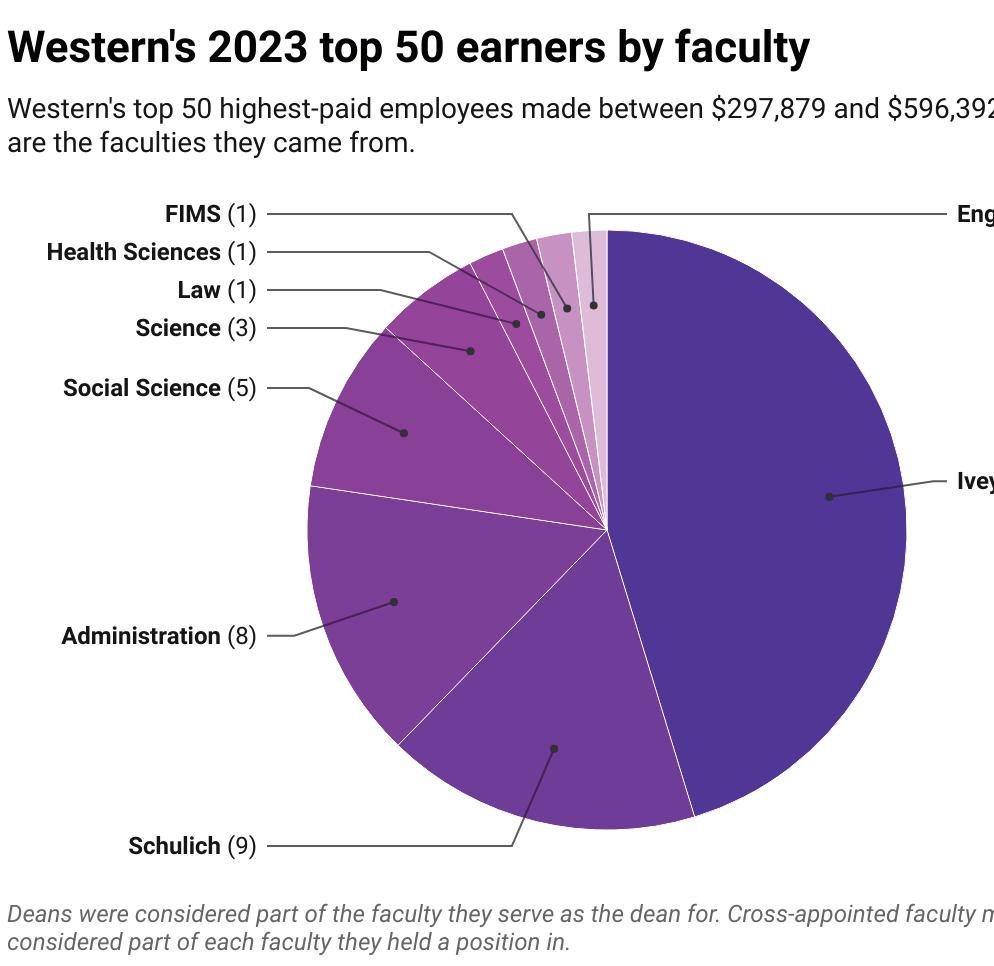

In comparison, King’s University College president David Malloy earned $311,941 with benefits and Brescia University College president Lauretta Frederking earned $296,429 including benefits. Brescia will integrate with Western in May.
Under Craig’s leadership, Huron has improved campus infrastructure with the opening of the
Huron University College president Barry Craig ranked eighth among Ontario’s top-earning university presidents, earning $433,876 between his salary and benefits. Craig earned more than the Queen’s University president — who took home $419,258 including benefits and the University of Ottawa president who earned $414,016 with benefits.
Frank Holmes Centre for Leadership, Ethics and Entrepeneurship Building and the new Burnlea Hall student residence opening in September, increased students services and maintained a low student-to-faculty-ratio to ensure small class sizes, wrote the a liate college in an email statement to the Gazette “Huron University is proud of its growth, as seen in this year’s OUAC data, with the highest increase in first year applications for Ontario Universities,” added the a liate college.
CONTINUED FROM P1
From Salat’s perspective, the absence of Anwer’s guidance has compounded the e ects of the conflict overseas in the Gaza Strip, along with the impact of the Nathaniel Veltman trial. Hooriya Zafar, a third-year sociology student at King’s University College, and Oloriegbe echoed his sentiments.
“[This] was the time that we probably needed him the most,” Zafar said.
The MSA has been calling for Anwer’s reinstatement since October, posting a statement on Instagram the evening of his dismissal. The statement said the association is “greatly disappointed and shocked by the rash dismissal decision” of Anwer during a time of great need.
The statement highlighted events such as the ongoing trial for Veltman, in addition to the IsraelHamas war — at the time three weeks after violence escalated on Oct. 7 — leading to an increase in reports of Islamaphobia on campus.
The MSA also started a petition calling for Anwer’s reinstatement on Nov. 1. At the time of publication, it had 2,509 signatures.
Salat explained Anwer’s dismissal has significantly impacted his executive team.
“Not only now do you have to deal with your own personal stu , you have to … continue to lead the students, and be expected to be that beacon of guidance for the students,” said Salat.
“It is a really big role to fulfill.”
The MSA currently supports a membership of 597 Western students, according to Salat.
Salat is unsure what the future will look like, as the MSA continues to call for more transparency, advocate for Anwer’s reinstatement and ask for increased levels of consultations.
The MSA’s initial statement said the university did not consult with the association leadership regarding its concerns about Anwer or its decision to dismiss him.
“There’s no concrete plan in place, and students are continuing to su er,” Salat said.
Prior to his dismissal, Anwer had been Western’s Muslim chaplain for just under two years since Shepard appointed him in December 2021.
But the advocacy for a Muslim chaplain began years earlier.
As the MSA’s advocacy director in 2019-20, Oloriegbe described advocacy for a Muslim chaplain as one of her largest projects. Though she said there wasn’t much progress in that first year, she said the Muslim community was very excited to have Anwer as a role model and mentor beginning in 2021.

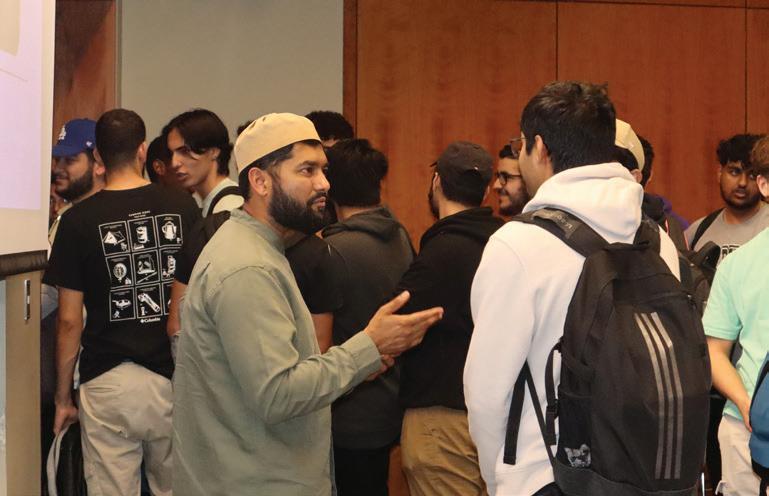
Zafar described how Anwer had a personal connection with numerous members of the Muslim community during his tenure in the volunteer position.
“Being a visible minority myself, it’s just really nice to know that there’s somebody has a little bit more wisdom … and an upper hand on understanding on how to operate in the world as a minority,” Zafar explained. “Through the time that he was here, it was a continuous support.”
In an emailed statement to the Gazette, Anwer explained another key aspect of his role was communicating with Western’s equity, diversity and inclusion o ce.
“I stayed actively in contact with the Equity, Diversity and Inclusion o ce, uno cially acting as a
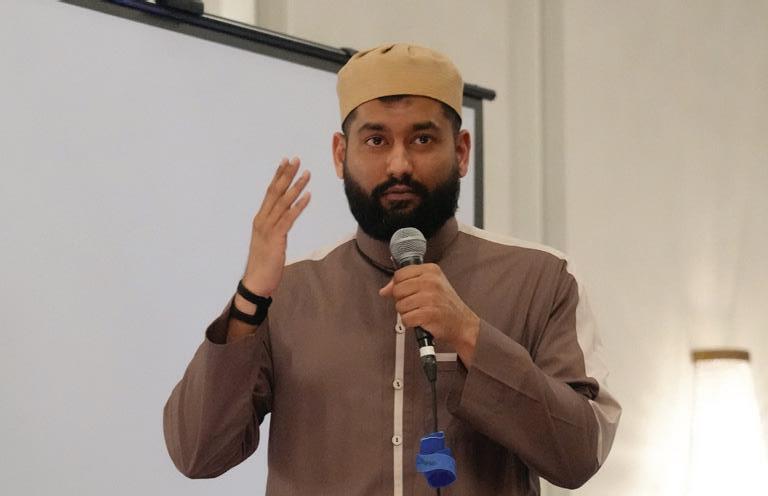
liaison between Muslim student needs and university administration,” Anwer wrote.
Oloriegbe and Zafar both described being left shaken by Anwer’s dismissal — they say it still impacts them and other members of their community to this day.
“I feel very concerned for our students who are left without one of the few support mechanisms available to them,” Anwer’s statement read.
Anwer does not advise the MSA in any o cial capacity anymore but still has a personal relationship with some individual students. Anwer spoke at the MSA’s annual end-of-year Iftar on April 17, o campus.
In its initial statement regarding Anwer’s dismissal on Oct. 26, Western said the divisive
comments made by Anwer do not align with and jeopardize “Western’s commitment to peaceful and respectful dialogue.”
The statement attributed to Shepard and vice-president equity, diversity and inclusion Opiyo Oloya did not specify which of Anwer’s statements led to his dismissal and did not clarify when asked by the Gazette
A day before his dismissal, Anwer posted a reply on X to Linda Frum, former Conservative Party of Canada senator and chair of the United Jewish Appeal Federation of Greater Toronto’s Committee to Counter Antisemitism and Hate.
“Stop spreading lies of beheading babies or rape of little girls. It’s been debunked,” his post read. “No one is celebrating the murder of Israeli babies. Palestinians are mourning the death of their babies. It’s incredible how Israel sympathizers simultaneously are the oppressor and the victim.”
He received several responses asking why he was retained by the university and tagging Western’s o cial X account @WesternU.
Anwer’s post was in response to Frum who initially posted “There exists no law in Canada to prevent this orgy of celebration for the beheading of babies and the rape and execution of little girls. Time for a new PM.”
After Western announced Anwer’s dismissal, Frum reposted Western’s statement and said she commended Western’s dismissal Anwer, who she said “accused her of lying about beheaded Israeli babies and raped Israeli girls.”
At the time, Western Hillel, a Jewish student organization, shared they “applaud” the university’s decision to remove Anwer in an Instagram story, citing “numerous discrimination and disinformation-filled social media posts” they say contributed to increasing tensions on campus.
The claim that Hamas beheaded babies, that began on Oct. 10, remains unverified.
Currently, there is no clear path forward for the university’s Muslim chaplaincy — the MSA and Western remain at an impasse.
“The responsibility of rehiring a chaplain should be on the university,” said Zafar. “And they should have done it promptly — which they didn’t.”
When asked how he is navigating the dissonance between the interests of the Muslim community and the university, Shepard said “I’m just waiting to hear back,” regarding nominations.
“That’s all.”
Hundreds of Western students and community members protested on campus March 28, calling on the university to divest from the fossil fuel industry and companies tied to the Israeli occupation of Palestinian territories.
The protest was organized in collaboration between Western University student groups including the Climate Crisis Coalition, the Palestinian Cultural Club, the Muslim Student’s Association and NDP Western as well as London-based organizations.
Protestors distributed a QR code and encouraged attendees to email Shepard and Board of Governors members with a pre-written letter signed by 19 student clubs and London-based organizations. The pre-written email called on Western to divest their assets from the fossil fuel industry, as well as divest from companies that are “directly involved in the illegal and ongoing occupation of Palestine, and the apartheid system that Israel continues to uphold.” This includes around $33.6 million from military contractors as well as $15 million from companies the student groups say “support Israeli apartheid.”
Western responded to the Gazette’s request for comment in a statement. The statement refers to
its decarbonization strategy but neither confirms investments in companies linked to the occupation of the Palestinian territories nor mentions divestments from these companies.
As of March 31, 2023, Western had around $63 million in investments tied to companies in the fossil fuel industry, including $8 million of Western’s mid-term portfolio, $50 million of their operating and endowment fund and an additional $5 million of the university’s private equity portfolio, according to Martin Belanger, director of investments.
There is a $2 million increase in Western’s operating and endowment fund tied to fossil fuel companies compared to the same period in 2022.
Maryam Oloriegbe, a fifth-year medical sciences student and Western Muslim Students’ Association member said the groups organized the protest to raise awareness about Western’s investments and educate others.
“I thought I needed to be here today to make my voice heard and make sure that Western can see this huge crowd today and really reflect on their investment practices,” said Oloriegbe.
Oloriegbe said a lot of the people attending the protest are Palestinian and she believes the investment practices are a ecting their family, friends and communities.
Speakers at the protest also spoke about concerns for the safety of Palestinian and Muslim
students on campus and encouraged students to report incidents as they occur.
Austin Wang, a USC councillor and outgoing co-chair of NDP Western, spoke to the crowd of protestors.
“Young New Democrats across the province and country stand in full solidarity with Palestine and call for immediate climate action,” said Wang, adding the Western NDP was happy to be there in support of something so important, along with several campus groups.
In a statement to the Gazette, Western’s vice-president of operations and finance Lynn Logan a rmed Western’s commitment to reducing the university’s greenhouse gas emissions by 45 per cent by 2030 and to achieve net-zero emissions by 2050 or sooner.
“A divestment strategy alone will not get our portfolio to net-zero. If we divest and another organization acquires that investment, we’ve had no impact,” said Logan in the emailed statement.
Western said it is pursuing a decarbonization strategy which aims to reduce or eliminate greenhouse gas emissions across all industries in its investment strategy and will divest from companies that fail to demonstrate progress toward decarbonization by 2030.
“Our responsible investing strategy acknowledges contributions are needed from all industries to
meet this global challenge — not just fossil fuels,” read the statement.
Protestors gathered in front of University College at noon before they marched around campus, passing by Stevenson Hall where the o ce of Western president Alan Shepard is located.
As they marched around campus, the protestors could be heard chanting slogans including “the people united will never be defeated,” and “What a shame, what a shame, it’s all just a money game.”
In February 2022, the University Students’ Council voted unanimously to sell the council’s $3.1 million investments in the fossil fuel industry by 2025. As of February 2024, the USC was close to completing its divestment from fossil fuels a year ahead of schedule, according to VP communications and public a airs Tamsen Long.
The University of Windsor Students’ Alliance — the university’s student’s union — passed a Boycott, Divest and Sanction motion on March 26, calling on the university to ensure it does not support or profit from companies that make money from Israel’s war in Gaza.
“I’m really proud of the fact that we were able to gather all these either student organizations or London-based organizations to come together and stand for one cause,” said Oloriegbe. “It really shows how much power is in the collective.”
The USC announced its newly-hired vice presidents on March 25, completing the executive team for the 2024-25 school year. The five VPs will join incoming president Emilie Kalaydjian.
Sarah Fullerton will be the University Student’s Council’s next VP orientation and programming, Daniel Klapper will be VP student services and Shreya Menon will be VP student engagement. They will work with elected incoming vicepresident university a airs Mariana Batista and incoming vice-president external a airs Michelle Wodchis-Johnson.
Fullerton is a fourth-year psychology, biological anthropology and archaeology student. She says a huge part of the orientation and programming portfolio is the project management aspect and creating programming that is representative of all students.
“The number one thing I want to ensure I do in o ce is make sure that all of the students working underneath my portfolio feel completely supported,” said Fullerton.
Fullerton wants to enhance the educational experience of all Western students by organizing both large- and small-scale events that cater to a diverse student body.
Klapper will take on the role of VP student services. He has already been in talks with the rest of the executive team for the last few days about what next year will look like and wants to sit down with the team to develop a more complete plan.
“We’ve been talking in hypotheticals for the last couple of days and really discussing what we want to get done,” said Klapper.
Klapper said one of his goals is to identify the areas in the USC that need maintenance, as well as the areas that need to be expanded upon to cater to student needs.
“I’m only two days into this, so I still have a lot to learn,” said Klapper. “But I’m prepared to get that done and to work with my executive team to accomplish that.”
Menon is a fourth-year political science student with a minor in media, information and technology. She wants to meet students where they are by going





ALondon police report revealed police spent $311,076 to promote public safety and address parties during Western’s Homecoming last September — a 16 per cent increase from last year.
This marks a drastic increase of $45,921 from last year, which cost taxpayers $265,155, according to the London Police Service’s 2022 and 2023 Internal Task Forces Report.
Over HOCO weekend, London police issued 315 charges — including 38 Liquor Licence and Control Act charges, 16 Highway Tra c Act charges, 10 bylaw charges and two Criminal Code charges.
In addition, London police also handed out 249 fines for nuisance parties, excessive noise and parking violations.
London police said they had a “busy weekend” responding to unsanctioned gatherings that saw around 10,000 people at the event’s peak during the day on several London streets, according to a press release.
London police temporarily closed Broughdale Avenue and Epworth Avenue to keep attendees safe, along with the help of out-of-town police officers from Windsor, York Region and Hamilton. Police blocked o streets with large vehicles to control foot tra c in the Old North area, and emergency crews used barricades to keep partygoers o the roads.
LPS inspector Ryan Scrivens said the daytime crowd was cooperative with police, fire and paramedic services. But later into the night, some peo-





to di erent groups on campus and club events to put a face to the USC that students can trust.
“I’m really excited to use my experience in the community communication field to get this done,” said Menon.
One of Menon’s priorities as an incoming executive member is to build the USC brand through storytelling and engaging with di erent media outlets.
“We’ve gotten a lot of feedback that we’ve been giving students a lot of information, but not necessarily taking their feedback into consideration,” said Menon. “So I really want to develop a solid two-way stream of communication.”
Council renamed the VP communications and public a airs position, changing it to VP student engagement at their Jan. 24 meeting. The name change reflects the role’s emphasis on community engagement initiatives and communication between students and the USC.
Fullerton, Klapper and Menon were selected by six-person internal hiring panels. The outgoing USC president, Sunday Ajak, outgoing VP for the hired position and USC senior manager of people and development are non-voting members who provide suggestions to the three voting members who make the final hiring decisions. The voting members are the incoming president, a USC board of directors member and an elected USC councillor.
The USC’s incoming VP university a airs, Batista, and VP external a airs, Wodchis-Johnson, were voted in by council members at their Feb. 28 meeting.

ple were observed jumping from rooftops, throwing cans and bottles at o cers and police vehicles, damaging property including a police vehicle and removing street signs and trees from the ground.
“Some of these behaviours had the potential for life-changing consequences,” said Scrivens. “We are fortunate that we did not have any serious injuries.”
The London Health Sciences Centre confirmed 31 patients were treated in relation to the unsanctioned gatherings.
“Western has been a key partner in the City’s Unsanctioned Street Party task force, which brings together agencies from across London with a shared concern for the safety of those who participate in large unsanctioned gatherings and with a shared responsibility for the safety of the community overall,” wrote the university in a statement to the Gazette




Seventy-five of 92 council members — 81.5 per cent — cast a ballot in the election, reflecting about a five per cent decrease in participation since last year.
Batista was elected vice-president university affairs with 41 votes — 54.7 per cent of the ballots. In her role, she will be responsible for advocating to Western University on issues students face.
The VP university a airs vote was conducted with a ranked ballot, and determined Batista as the winner in the fourth round.
Wodchis-Johnson ran unopposed and won with 73 votes — 98.6 per cent of the ballots. She will be responsible for advocating to external stakeholders in the municipal, provincial and federal governments on student issues.
Batista is a fourth-year health sciences student and current health studies councillor in the USC. She ran on a platform focusing on academics, sustainability and transitioning Brescia University College students to main campus.
“I’m so excited to get started on working on some of the tools that I had, and just talking to everyone and seeing what the priorities are for next year,” said Batista in an interview with the Gazette. “I’m so, so excited.”
She plans to advocate for a more streamlined academic accommodations system and help reduce food waste on campus by advocating for a food redistribution system. Batista’s first goal in o ce is to build a rapport with councillors to prepare them for their role.



Western’s Senate approved the creation of the Brescia School of Food and Nutritional Sciences e ective May 1. Due to the increased number of students, the faculty council will also receive an additional seat on the USC.
According to the Senate agenda, the new school will allow the program to have the disciplinary oversight of their curriculum and resources to meet the College of Dieticians of Ontario’s accreditation standards and facilitate the dietetics program graduates for registration with CDO.
“For accreditation, the programs need to have the authority and control over the curriculum,”



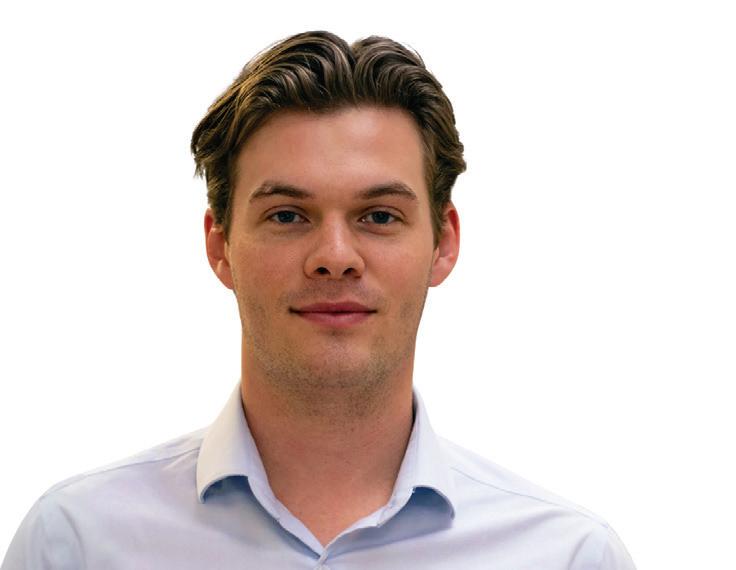



Batista ran against four other candidates — Jenna Beecroft, Siddharth Maheshwari, Ankita Mishra and Eric Scarfone.
Wodchis-Johnson is a fourth-year political science student and is an external a airs coordinator in the USC. She also serves as the associate VP internal in the Social Science Students’ Council.
“I’m so grateful to everyone who elected and anyone who consulted with me, and just everyone who’s supported,” said Wodchis-Johnson in an interview with the Gazette. “I can’t wait to just continue all over the really strong external advocacy e orts we’ve been doing.”
She hopes to take a student-informed approach to advocacy and make her role more approachable through social media. The incoming VP external affairs said the first thing she wants to do is reinstate the town and gown committee — a forum for communication between students and city council.
Incoming USC president Kalaydjian said in a statement to the Gazette she values the di erent strengths each VP brings to the team.
“I am really looking forward to working and growing with them so we can learn how to further support the student experience here at Western,” wrote Kalaydjian.
— With files from Adshayah Sathiaseelan Editor’s Note: Incoming VP student engagement
Shreya Menon was previously a Gazette video intern in first semester of Volume 117, but is no longer a liated with the Gazette.
said Jayne Garland, the dean of health sciences. “That is more easily done if you have your own school because then you have your own curriculum committee and your own approvals.”
Garland said the faculty has provided supports to food and nutrition students currently at Brescia University College who will be transferring to main campus after the merger.
One of the academic advisors from Brescia will transfer to the Faculty of Health Sciences and members of the Faculty of Health Sciences’ Students Council have reached out to incoming students, explained Garland.
The FHSSC president Sanjana Jones brought forth a motion during the University Students’ Council meeting on March 20 to add a fifth councillor to their faculty council.
The USC’s Council Composition Procedure states that each faculty gets one base councillor and an additional councillor per thousand students. There are currently four seats allocated to FHSSC including the president.
But, Jones said the Faculty of Health Sciences already has over 4,000 students and will increase to around 4,500 after the Western-Brescia Merger, so the faculty should have five seats.
The motion passed unanimously and the fifth councillor will be elected in the 2024 fall byelection.
Cheating’s existed forever. It isn’t new with AI, there’s just one new technology, one new opportunity, if people choose to engage with academic dishonesty







jersey, I feel like it’s a responsibility, you get to show people who you are and who your country is
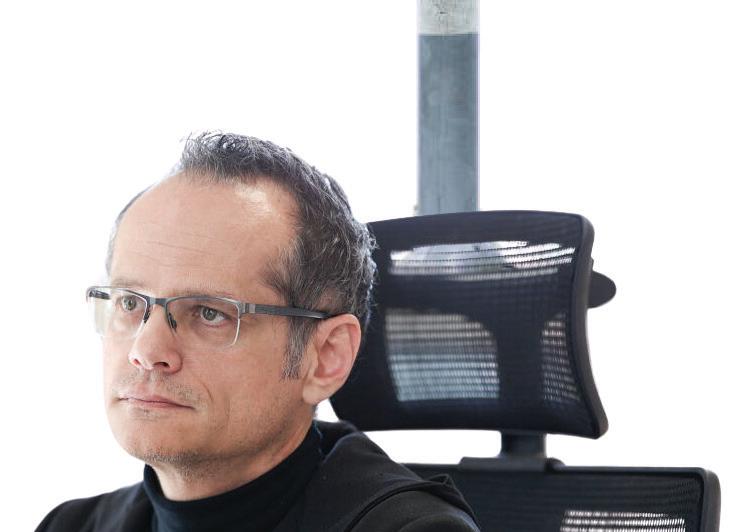
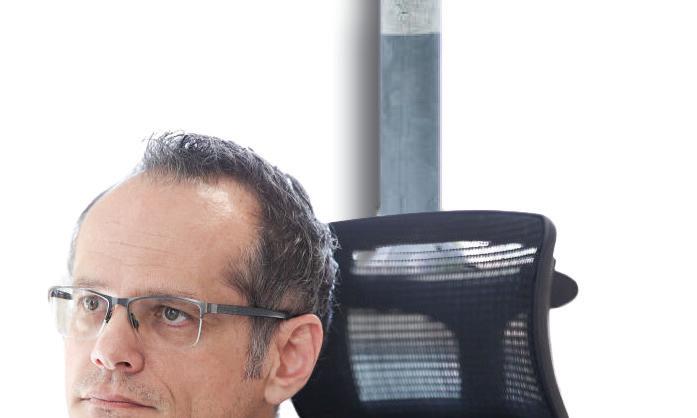


 — Mark Daley, Chief AI o cer at Western
— Mark Daley, Chief AI o cer at Western












If I can identify a few things at a time, and ask questions and apply pressure, I can limit some harm. Every bird that doesn’t bump into a window at Western because the window’s been treated — that’s a life saved, right?
My sister’s death really changed everything for me. I’m not sure I would have lived the life that I ultimately chose to live if she hadn’t died. It made me really appreciate everything I had, and appreciate life and make sure that I really did something that I love.



—Diane Goodman, former senior coordinator at the UNHCR and Western alumna





— Olivia Ghosh-Swaby, PhD candidate in neuroscience and executive director of OWIFA








THERE IS A SPACE NOW WHERE WE CAN BE SOME OF THE BEST ATHLETES IN THE SPORT


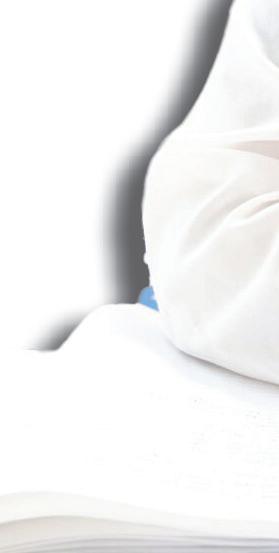








The 2023-24 school year was dicult.
Brescia University College’s closure was announced. Students protested Western University’s investment into fossil fuels. The community felt the impact of the ongoing Israeli occupation in Palestinian territories and the Israel-Hamas war. Western launched an investigation into the Mustangs hockey coaches, following allegations of sexual misconduct and abuse. But there were moments of pride as students continued to achieve and accomplish. More than anything, communities came together in solidarity — reflecting the strength of student voices.
Every year, the Gazette photojournalists work to capture the biggest moments at Western — encapsulating the campus community’s grief, joy, anger and unity. Find our collection of photos we feel tell Western’s story this year, modelled after the New York Times’ Year in Pictures.




GAZETTE



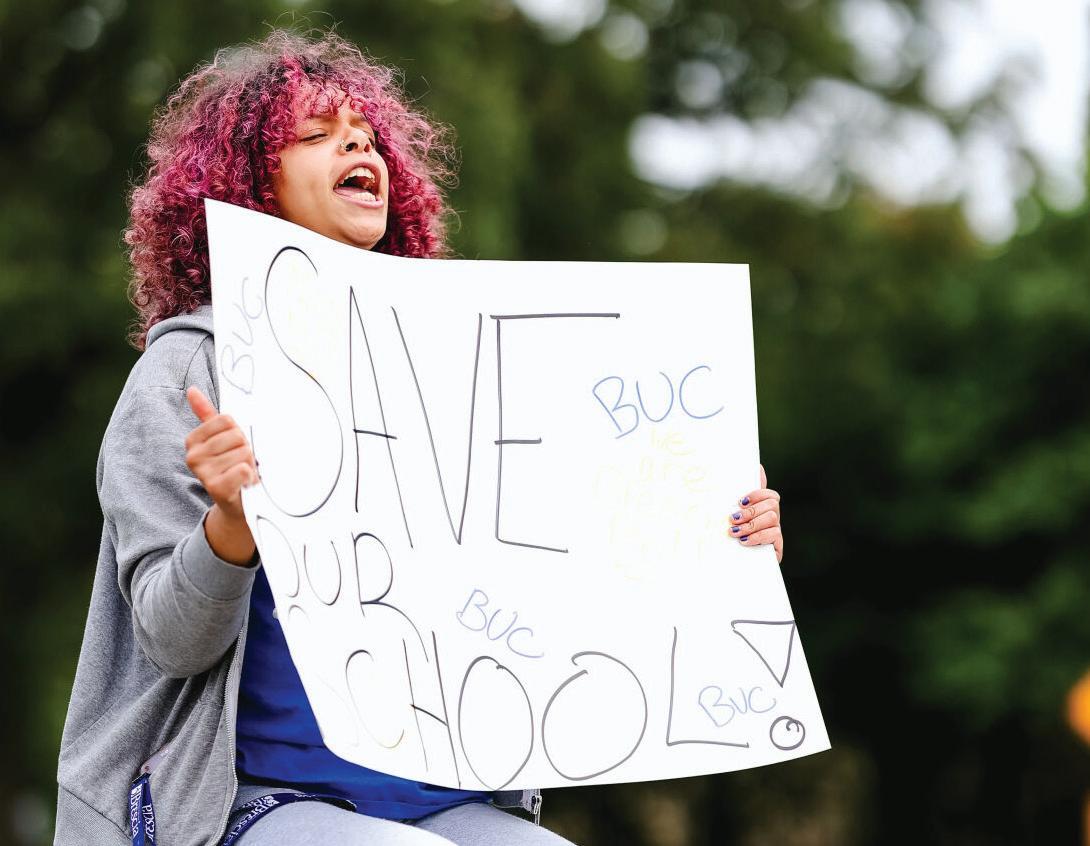



Western announced on Sept. 21, 2023, that Brescia University College would be integrating with the university in May, raising concerns among both the schools’ faculty unions who were excluded from consultation as well as a liate students who expressed shock and anger. Around 200 Brescia students and faculty members gathered on Brescia Drive
Sept. 27 to protest the merger.



On Oct. 12, 2023, members of the International Union of Operating Engineers local unit 772 — responsible for heating, ventilation, utilities and air conditioning systems
Western — went on strike, due to concerns of sta ng shortages, safety concerns and non-competitive wages. While picketing, a vehicle struck three operating engineers, injuring one. On Oct. 16, 2023, a tentative agreement was reached.












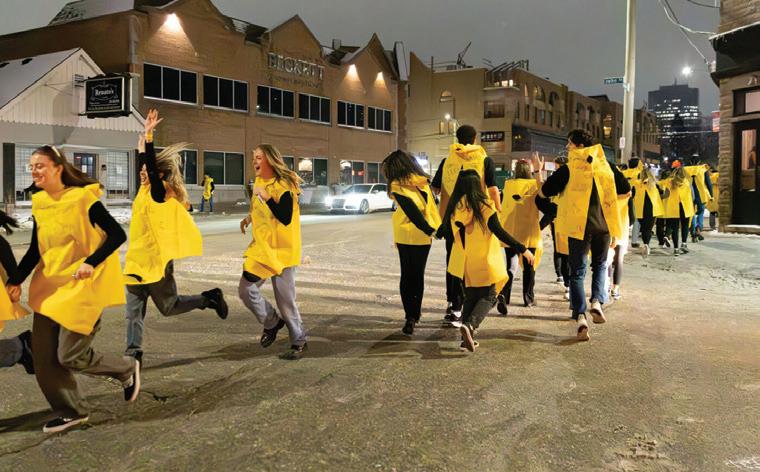



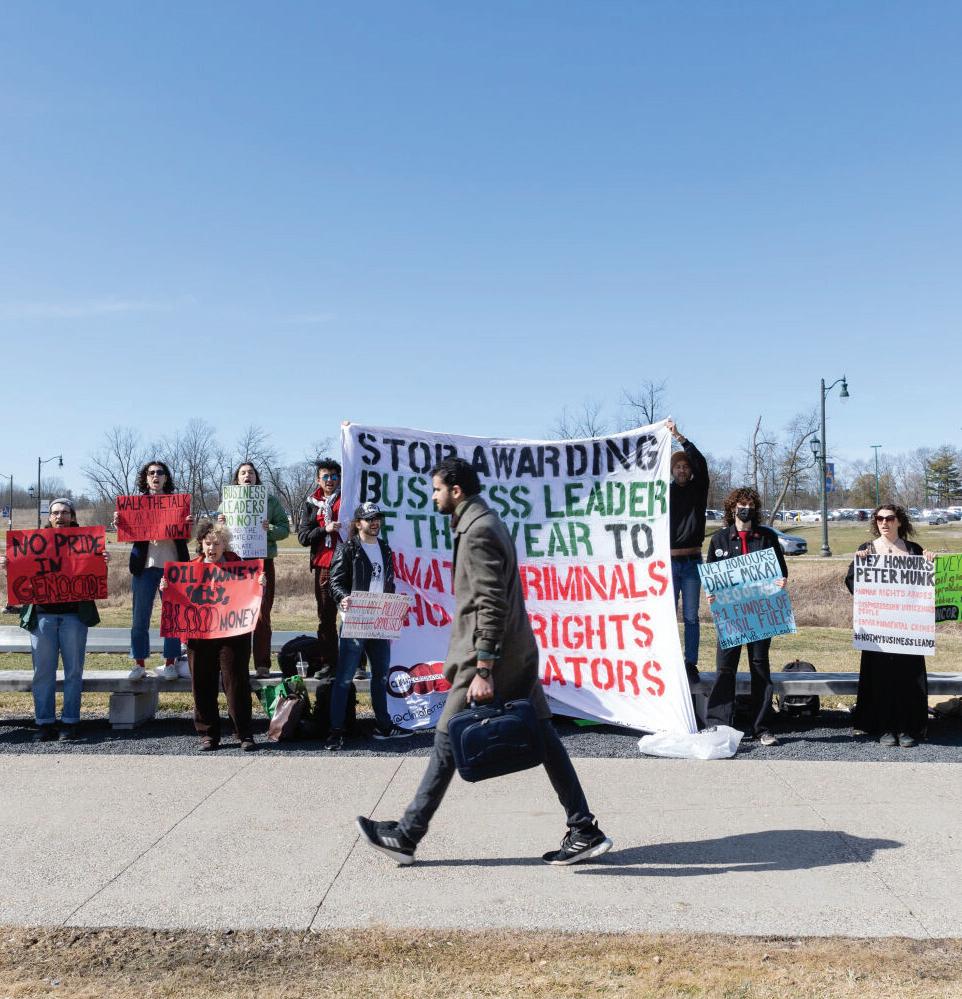


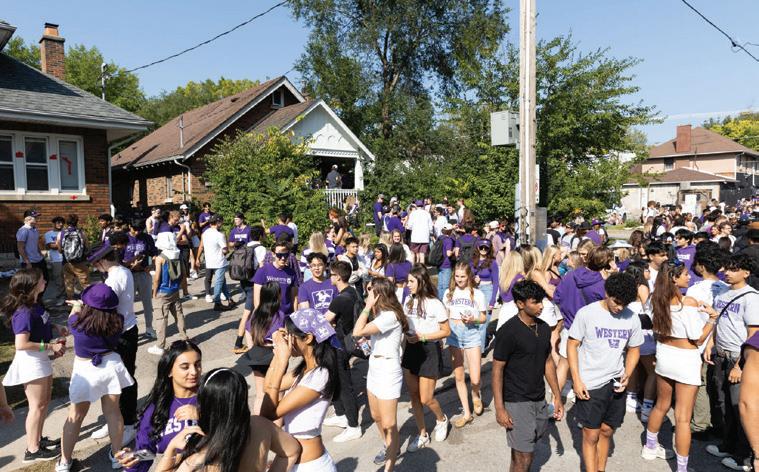






Sorrell worked as emergency medical responders in Alberta this summer as wildfires raged through the province. Extreme forest fires caused Alberta to declare a state of emergency on May 6, 2023, and more than 24,000 were evacuated from their homes in the northern areas of the province.


Emilie Kalaydjian was elected the president of the University Students’ Council for the 20242025 academic year in a race that saw three candidates vie for the position. Kalaydjian won with 52 per cent of the vote, with 21.6 per cent of the student body voting — the lowest per capita since 2020.


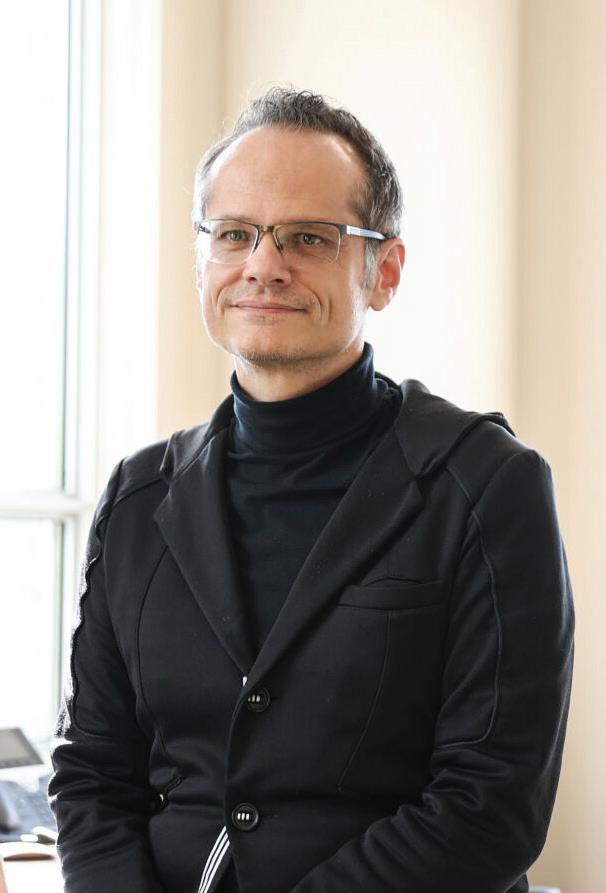

Western







Over 100 students gathered in front of the University Community Centre to raise awareness of Hamas-held hostages on Oct. 25, 2023. Each student held a sign with the name and photo of a hostage.


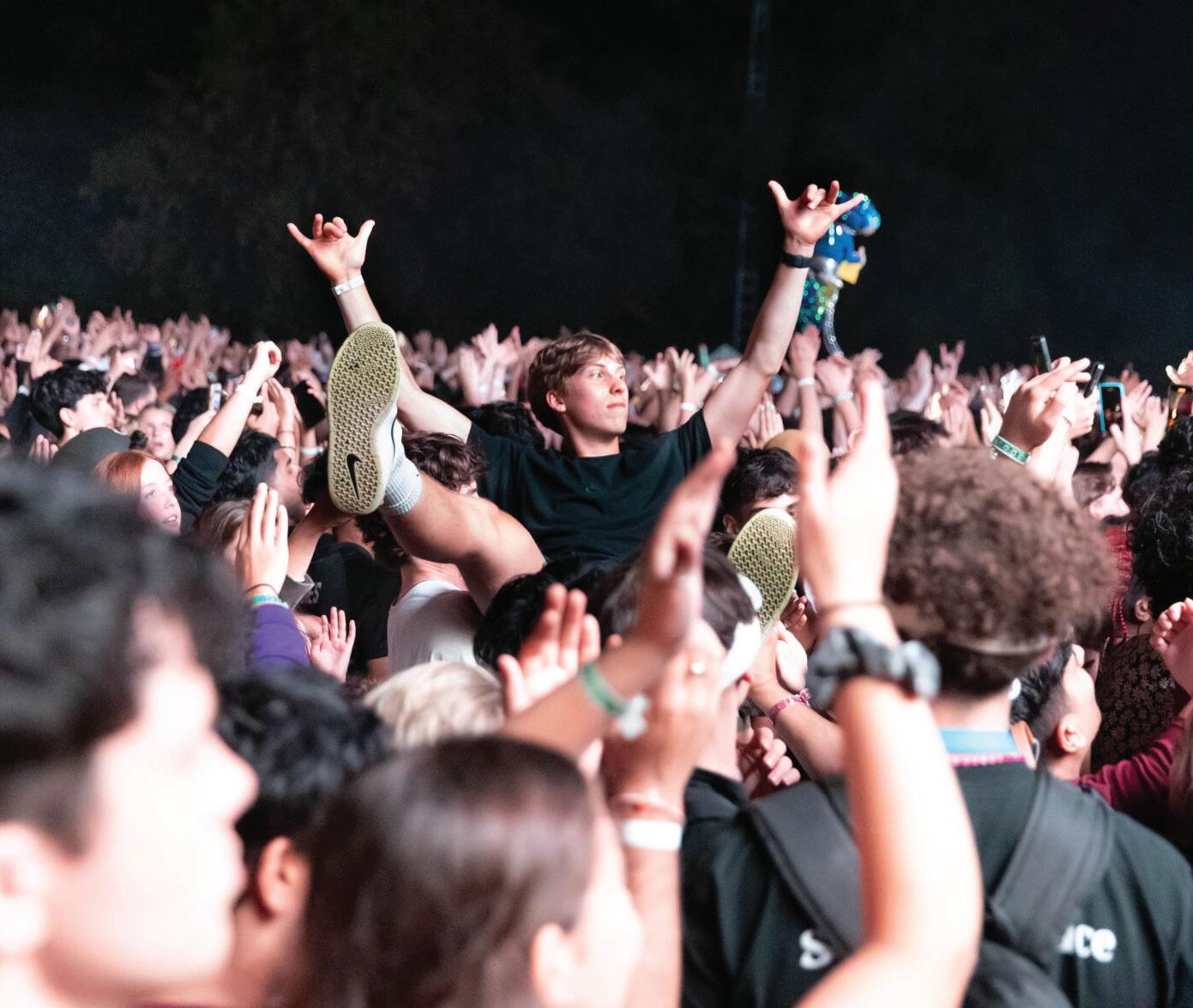


Around 4,000 first-year students gathered for high-energy OWeek 2023 closing ceremonies featuring headliner T-Pain. During the ceremony, rowdy crowds of students led to the concert being paused for safety after SERT responded to calls on the practice field, but no major injuries were reported.



Nhial Deng was born in South Sudan, then fled to the Kakuma Refugee Camp in Kenya where he spent the next eleven years. Now, the third-year global studies student at Huron continues to advocate for global human rights and was recently honoured with the prestigious Chegg.org Global Student Prize.


Olivia Ghosh-Swaby led the creation of the Ontario Women’s Intercollegiate Football Association, growing inter-university games from a Facebook group into a formal tournament structure. Western women’s football team has dominated OWIFA tournaments, bringing home all three championship wins since the league began.
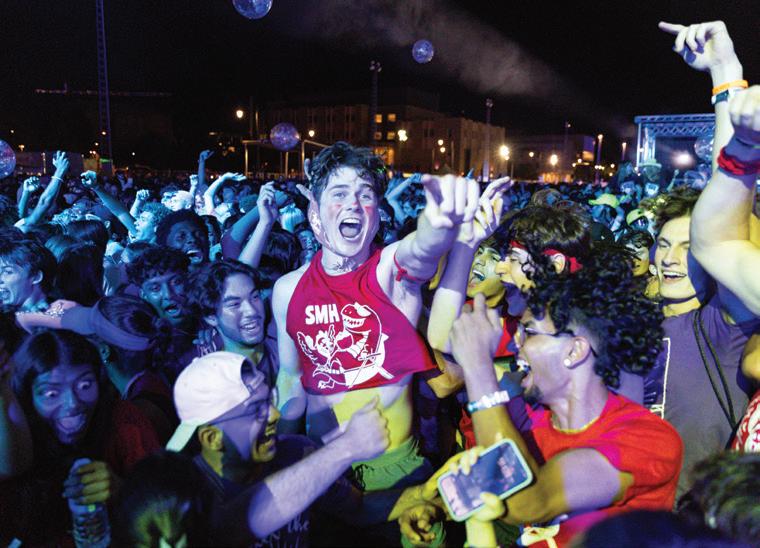






Western launched an investigation into the university’s women’s hockey program amid multiple allegations against head coach Candice Moxley and strength and conditioning coach Je Watson in September. Over 50 scholars called for a broader investigation into the university’s athletics department. The investigation found allegations against Watson to be substantiated and he is no longer with the university. Moxley has since returned as head coach.


Librarians and archivists averted a strike at 10:54 p.m. on Oct. 3, 2023 — one hour before the strike day. UWOFA-LA was prepared to go on strike due to concerns about pay, benefits, workload and the length of the collective bargaining agreement. They later reached an agreement with the university in November.
Hailey Shepstone loved playing chess and checkers with her grandparents at every Sunday dinner — even if she had to re-explain the rules to her grandfather every time.
The first-year music student has only ever known her grandfather with Alzheimer’s disease. She says that while the experience is di erent, it’s not as negative as others may assume.
“Every single time I have to re-explain,” says Shepstone. “But it’s so worth it because he gets so happy.”
Dementia is an umbrella term generally used to describe memory loss, slowed thinking and declined cognitive abilities that interfere with a person’s day-to-day life. Common types of dementia include Parkinson’s disease, Lewy Body disease and Alzheimer’s disease, which accounts for 60 to 70 per cent of all people with dementia.
In 2020, 8.4 per cent of Canadians over 65 had some form of dementia. According to an analysis of Ontario Health Insurance Plan billing, the number of dementia patients in Ontario has increased 48 per cent since 2010.
Leslie Rand, director of development at the London Alzheimer Society Southwest Partners, says in their region — which includes Middlesex, Elgin and Oxford counties — the number increased 51 per cent, slightly higher than the provincial average.
About 14,600 people will be living with dementia in the Middlesex, Elgin and Oxford counties in

2024, according to Rand. In January, their agency received over 200 new referrals — which she adds is “a lot”.
Although some may associate the rise of dementia with smoking, high blood sugar and obesity, Dr. Stephen Pasternak, a cognitive neurologist and scientist at Robarts Research Institute at Western University, says the cause of dementia remains unknown.
“We look at the brains of our patients who’ve succumbed to dementia,” says Dr. Pasternak, adding that by the time he sees a patient, there are often other health concerns at play as well.
“It’s very hard to go back and say, “Aha, it was this first,”” Dr. Pasternak continues.
However, he does point to the aging baby boomer population and increased average life expec-
tancy as potential factors for the increased rates of dementia.
Rand says this increase creates a major strain on the resources of organizations like London ASSP, which provide dementia education, counselling and services for individuals with dementia and their caregivers.
“What happens for us is the sta carry a tremendous amount of weight. It’s hard for them — they want to help everybody, and seeing waitlists grow is frustrating,” explains Rand.
At the age of 65, one per cent of the population may have dementia, and this rate doubles every five years. In a room full of 85-year-olds, Pasternak explains a quarter to a half of the room will have some form of dementia.
Shepstone’s stepfather is her grandfather’s primary caregiver — although he is able to continue working, the time-consuming role of being a caregiver can interfere with tasks like vacation planning and meal prepping.
Additionally, her grandfather receives support from a weekly Alzheimer’s program and other family members.
“I don’t know what he feels on the inside. I don’t know if he recognizes, “hey, I’m di erent than everybody else,” but at least he’s surrounded by people who have the same challenges,” says Shepstone. “If he does on a subconscious level recognize it, he knows that he’s not alone.”
There’s no cure for dementia, with symptoms being progressive and worsening as one ages. The pro-
gression of the disease means more support is required from caretakers, such as bathing and eating. Often, as the seriousness of the disease increases, caregivers must take time o of work or consult external resources for extra support. Dementia caregivers can qualify for EI caregiver benefits because more than one in six dementia caregivers have to completely quit working to support their caregiving duties.
Dementia caretakers are often forgotten, but sometimes need more care than the patients themselves, says Pasternak.
“Many of the times in my clinic, my patients are a ected, but usually I’m much more worried about the caregivers than I am my patients,” he says. “Often, I think we’re treating the wrong person”.
Pasternak advises caretakers to connect with the Alzheimer Society of Canada for resources such as dementia education courses, day programs, social workers support groups and more.
Shepstone is unable to see her grandfather as often as she could before arriving at Western last fall, but still appreciates the luxury of playing chess and checkers with him whenever she can.
“In the beginning, I was more focused on the fact that he had Alzheimers. I was worried about what if he doesn’t remember me, how do I act around this person,” says Shepstone. “As I got to know more and we grew closer, I realized that [we should] really focus on the time that we’re spending, even if he doesn’t remember it later.”
Fueled by student power and engineer ambition, Western’s Formula Racing team revs into another year of electric car racing.
Western University’s Formula Racing team is a Western Engineering club mainly made up of undergraduate engineering students who work together to build a full-scale electrical racecar every year. The project intends to hone the engineering skills of students part of the project.
After completing the build, they participate in wide-scale racing competitions against major worldwide universities’ Formula Racing teams.
“We’re here pretty much all the time, we live in this o ce,” says Kaneil Bajwa, a sixth-year mechanical engineering student who leads the high-voltage battery subsystem team.
“It is taxing especially as students because we also have a full-time course load,” Bajwa adds.
The construction process has three distinct phases every year: design, manufacturing and test driving.
The design process goes from the summer until December. Following design is the manufacturing process, which lasts until the spring. Lastly, they test drive the car before the Formula Society of Automotive Engineers — Formula SAE — held competitions.
Bajwa shares that there are two categories of competitions Western’s Formula Racing team attends: Formula SAE-sanctioned events and shootout races — informal competitions organized by other student formula teams at universities across Canada and the U.S..
“You show up and go fast. That’s pretty much it,” Bajwa says about shootout races.
Western’s team attended a University of Toronto shootout in Toronto last October.
In contrast, the Formula SAE-sanctioned ones have more rigid requirements — such as a design event.
Bajwa says that the design event involves industry professionals, “essentially grilling you on your designs.”
“There’s a cost report, you have to go through a pretty extensive, rigorous, technical inspection that lasts multiple days,” says Bajwa.
At the end of April, they’ll attend a Formula SAEheld competition in New Hampshire — marking the start of their racing reason — and another at the end of June at the Michigan International Speedway.
So how does the electric car work?
There are five major and four minor subsystem teams within the Western Formula Racing team. The major subsystems are chassis, suspension, aerodynamics, GLV and traction. The minor subsystems are steering, brakes, ergonomics and wheel assemblies.
Bajwa shares batteries and steering serve as major challenges in the construction process.
The batteries are the main energy source of the car, and its structure is designed to ensure a failsafe in any crash scenario. The construction of the battery requires a lot of rigorous testing and thermal management as it gets really hot during races.
“We do quite a bunch of rigorous testing of these new advanced engineering materials,” says Carson Eccles, a fifth-year mechanical engineering student and technical director. “It’s a good way for people to get hands-on experience for material testing.”
While the team is mainly made up of engineering students, you don’t have to be an engineering student to join.
Rachel Bell, a third-year mechatronics engineering student and member of the electrical section, says her advice for anyone interested in joining Western Formula Racing is to just consistently show up.
“Don’t be afraid to insert yourself into situations where you may not know anything or may not know enough or think that you don’t know enough,” says Bell.
Despite Western Formula Racing’s large team and student power, they still receive external help towards their yearly project, especially from sponsors.
The sponsorships can be cash flow for purchasing o -shelf components and entering competitions or through manufacturing labour.
For example, this year, Western Formula Racing team custom-designed car parts, and then sent 3D models to their sponsor for construction. Sponsors provide the resin the team uses to wrap their carbon fibre parts, which are wrapped in resin.
Minus the students’ labour hours — which are unpaid — the annual budget spent on the vehicle is $200,000.
“What makes the racing season and the manufacturing season go a lot smoother is the attention to detail and thoroughness in design,” says Bajwa, adding that the team kept track of the materials and used a 3D modelling software to track their progress.

The global racing competition, Formula One, has recently garnered more attention from both racing fans and non-fans.
Bajwa says this recognition has fostered more interest from students in Western’s Formula Racing team and has been helpful for recruitment.
As engineering is a male-dominated field, it is no surprise that the team is predominantly male
as well.
The team’s resources and size shift on a year-toyear basis, hence they aim to document all of their progress to ensure that the knowledge of graduating students gets transferred to younger students.
“Sometimes that makes things go a little bit slower. But it’s absolutely worth the investment in the future,” says Bajwa.
says a has been positive.
Bell says her experience as a woman on the team
“The girls that have joined the team do a good job of paying special attention to each other,”
the special says Bell.


“Showing consistency is enough to have you integrated into the team,” says Bell.





Bell nervous a woman on the team, by showing up consistently she found herself integrating into the team faster than she thought.
Although Bell was initially nervous about being a woman on the team, by showing up consistent-



When Alan Shepard signed on to be Western’s president, he never imagined he would be gifted a house — and be obligated to live in it.
“It’s actually in my contract, and I’m required to live there, which is unusual,” says Shepard.
Similar to how the President of the United States resides in the White House, the Western University president’s o cial residence is Gibbons Lodge.
The lodge is a 125-acre property behind Masonville Mall, located on the east side of Richmond Street and north of Highway 22. Before Shepard moved in, Gibbons Lodge had already been home to seven presidents.
“It’s an incredible place,” says Shepard. “It’s a little shabby around the edges — the furniture is not new and not really to my taste, but the university has done an excellent job of keeping up the plumbing and whatever.”
For Western’s president, Gibbons Lodge is a place to host events — whether it’s a meeting with the new slate of University Students’ Council executives to discuss their plans or a formal dinner to thank a donor.
Shepard likes to cook the dinner himself when hosting senior leaders that he is hoping to recruit to the university.
“It’s a very warm gesture to show ‘I really want you to be on the team,’” says Shepard.
Shortly after Shepard left his post as Concordia University president and arrived at Western in 2019, he commissioned then-fourth-year history student Marshall Cosens to delve into the history of Gibbons Lodge.
The result of Cosens’ work was a 10-page report he compiled by looking through the archives at the London Public Library’s Central Library branch, online databases and newspaper clippings.
But Cosens hit a roadblock when the COVID-19 pandemic started, as he couldn’t visit the archives in person.
Fortunately, he was put in contact with a gentleman named Tony Little, the nephew of Helen Beresford Gibbons — who owned the property before it was acquired by Western in 1961.
Helen bought it as a white farmhouse in 1928 from the Farncomb family, who had owned it for around 60 years. She demolished the farmhouse to build a new residence. With the help of builder


to the University of Toronto president, Sidney Earle Smith.
the equivalent of $2.478 million in 2024 — with $200,000 payable in cash and the balance secured by a mortgage.
The beneficiaries of Helen’s estate agreed to contribute an equal value of the first mortgage for the purchase of the property — giving the house to the university with the remaining donated “through the kindness of other friends of the university.”
On April 12, 1961, the agreement with the City of London was formalized, and the university was officially the new owner of the 125-acre property. Its first residents were Hall and his wife.
Throughout the years, presidents have renovated the house to suit their tastes and comforts.
Shepard says he could have added more new furniture if wanted, but he’s a cautious person when it comes to money.
“It’s more grandma-like than I would have put in. I would have more modern taste, but I haven’t really changed any of the furniture,” says Shepard.
But the president did have the whole house repainted and also chose 32 di erent art pieces from the university’s art gallery.
According to Shepard, Helen lived there for around 30 years by herself — and some sta members who lived in the apartment above the garage — and died without a will in September 1960.
“At that point, her nieces and nephews tried to figure out ‘what are we going to do with this property’, and so the answer was to gift it to the university,” says Shepard.
Western’s solicitor — the university’s legal counsel — was Frank Little, the husband of Helen’s niece Lucy Gibbons. It was likely this connection prompted Western to select Helen’s home as the president’s future residence.
The Gibbons family also had a long-standing relationship with Western. Helen’s father, Sir George Christie Gibbons, was one of the original members of Western’s Board of Governors in 1908 when the university became non-denominational — not restricted to being a denominational school of the Church of England. He was also a contract law professor at Western.
Cosens determined at the time of Helen’s death, the university was searching for a suitable residence for the president.
He found a letter written on Sept. 16, 1956, from then-Western president George Edward Hall
Hall was inquiring about the UofT presidential house and what assistance the university provided for the president’s living expenses.
According to Smith, UofT o ered a residence, a car, covered heating, telephone and helped pay for three servants and a gardener.
“I got the sense that he was jealous that other university presidents had a living quarter that was paid for,” says Cosens.
Shortly after Hall’s exchange with Smith, the university purchased the house.
Cosens believes Western’s desire to purchase Gibbons Lodge was likely driven by the precedent set by other major universities, and the aspiration to maintain the university’s status as a prestigious institution.
In early 1961, the university’s Board of Governors formed a special subcommittee to investigate the terms and conditions regarding the availability of Helen’s property. The committee members included some notable names, including D. B. Weldon and Richard G. Ivey.
On March 22, 1961, Helen’s heirs approved the sale of the Gibbons Lodge estate for $245,000 —
“I felt sort of greedy at first saying, ‘Can I have these 32 pieces?’” says Shepard. “And they said, ‘These pieces are sitting in the dungeons for years and decades. Please show them.’”
So Shepard asked for a booklet that described each piece, and who owned and painted it. Now, when his guests ask him about a piece, he pulls out the booklet and is ready to share.
According to Shepard, Gibbons Lodge isn’t always as glamorous as it seems — like when he steps out of his house and comes across a pack of wild animals.
“So I came out of my house this morning to get in my car, to come to work and I looked to my right and I thought, ‘What is a German Shepherd doing sitting in my yard?’ And I looked again, and it was a coyote,” says Shepard, smiling.
Shepard says the animals come in cycles, with the occasional skunk, followed by a herd of deer, then a herd of wild turkeys and back to the coyotes again.
But he’s not complaining, he says it’s his favourite part of being a resident of Gibbons Lodge.
“It’s a real honour to live in a place that’s got so much history associated with it, and we try to use it really well,” says Shepard.
Two Western University students, Kaya Anderson and Ulrica Samuels are redefining health care — one interview at a time.
Kaya, a third-year gender and women’s studies student, and Ulrica, a fourth-year kinesiology student, are the co-hosts of The Black Aspiration Project podcast, where they interview Black healthcare workers and advocates for Black health.
Intersectionality is central to the podcast, as Kaya and Ulrica explore how race, gender identity and sexual identity intersect with health care and the community.
“An intersectional approach is always important because people’s experiences are influenced by their identities,” says Kaya. “Listening to people who have studied health or health care or Black communities is important for improvements in better health outcomes.”
The podcast first launched in the winter of 2023. Interviewees come from diverse backgrounds, extending beyond just healthcare professionals.
For example, Kaya and Ulrica interviewed Fatimah Jackson-Best, a professor from McMaster University, on the topic of advocacy on mental health, anti-Black and gendered Islamophobia. They interviewed Kevin Blanks, a high school literature teacher and English PhD student, on critical theories and how they can be used to build sustainable futures for the Black community.
Kaya and Ulrica met in the course Gender, Sexuality and Women’s Studies 3315: Blood, Breath and the Black Body, taught by Cornel Grey. The class incorporates Black feminist and queer theories to evaluate questions of health risks and care.
Kaya says her mom — who graduated with a gender and women’s studies degree and is now a midwife — inspired her to take the course.
“She worked at a clinic in Toronto that works with a lot of BIPOC women, newcoming immigrants and some people who are undocumented,” says Kaya. “I’ve grown up with this type of work, and Dr. Grey’s class was inspirational for me.”
Ulrica, who is minoring in sexuality studies, explains how this project intertwined her two academic programs.


“It combines the health aspect, public health aspect and intersectionality — some of those theories that are critical when analyzing healthcare,” says Ulrica.
Kaya attributes her decision to join as a co-host of the podcast to being influenced by Dr. Grey’s class, highlighting the readings, lectures and guest speakers. She saw the podcast as an avenue to further connections with the course lecturers.
Kaya and Ulrica both express interest in continuing the podcast past this school year, as they’ve been met with positive reception.
They encourage students to listen with an open mind and to take time to reflect on what the podcast is really trying to convey.
“This research project is an extension of who I am,” says Ulrica. “I think that is the main reason that I want to push this sort of work out to the broader Western community, and it’s talking about things that aren’t really talked about on the Western campus.”

Another year, another CFL combine and another wave of stand-out athletes stepping up to the plate.
The next potential Mustangs to go pro — Mohsen Jamal, Max Nixon, and Lourenz Bowers-Kane — participated in the Canadian Football League National Combine in Winnipeg from March 19 to 24 in front of former Mustangs players who earned a spot in the CFL.
This year, a total of seven mustangs showed o their talents in drills for the CFL Combine, with four more competing at the Waterloo Invitational Combine in early March.
Combines are multiple-day meets where players test their athletic skills. The first day consists of individual drills such as jumping tests, shuttles, dashes and bench presses. The next two days saw practice scrimmages and game scenarios for the players to show o their skill sets on the field.
Fifth-year wide receiver Jamal, known across the country for his agility, showed out in the speed tests. He was fifth in the shuttle with a time of 4.26 seconds, ran the 40-yard dash in 4.62 seconds for eighth and did the 3-cone in 6.76 seconds, which tied for second.
On the scrimmage days, Jamal proved he could use his pace against the best in university football, blitzing defenders in 1v1s.
For the 10 years that Jamal played football, he put everything into it — day in and day out.
“‘I’m always doing everything that I can to get better as a player,” Jamal explains. “It’d be amazing to finally be on a pro team, get some money.”
Standing at 6’ 1” and weighing 229 pounds, fourth-year linebacker Nixon’s biggest strength is his mobility at his size.
In the individual tests, he broad jumped 9’ 1 7/8”, bench pressed 225 pounds 13 times and ran the shuttle and 40-yard dash in 4.46 and 4.97 seconds, respectively.
Nixon fell in love with the game while competing with his high school. He then went to Western University, won four Yates Cups, and claimed the 2021 Vanier Championship. Now, he’s focused on making his childhood dream come true — joining the CFL.
“Anything I could do to make that happen would just be awesome,” says Nixon.
Fourth-year linebacker Bowers-Kane participated in the first day of the combine but needed to step back after re-aggravating a groin injury he had su ered at the Syracuse NFL Pro Day on March 18.
Strength and tenacity describe Bowers-Kane’s game. He benched 17 times, ran 40 yards in 4.81 seconds, completed the 3-cone in 7.27 seconds and tied for seventh on the vertical by jumping 35.5 inches.
Despite the setback, Bowers-Kane understands that injuries come with the game and that having a strong mentality is just as important.
Bowers-Kane sees getting drafted into the CFL as an opportunity to prove himself amongst the best on Canada’s biggest stage. He was thrown onto the field at an early age and hasn’t forgotten the initial feeling of adrenaline rushing through his body.
“I would watch the greats Ronnie Lott and Ray Lewis, and I would see the aggression that they would come down, hitting people, and I was like, I like this,” Bowers-Kane shares. “I tried to emulate that same thing. I just fell in love with that.”
By showing o their skills at the combine, the three athletes join a storied history of Mustangs on the national stage.
In 2023, 13 former Western Mustangs were rostered into the Canadian Football League, but many more have found themselves in the league in its 66year history.
Success like this does not occur without the strength of the Mustangs’ coaching sta , led by head coach Greg Marshall.
Marshall started his career with the Mustangs in 1978 as a fullback in former headcoach Darwin



Semotiuk’s o ence. During his time as a player, Marshall secured a Yates Cup three-peat and the Hec Crighton Trophy, awarded annually to the most outstanding Canadian football player in U Sports.
After a championship-winning stint with the CFL’s Edmonton Eskimos, Marshall returned to his alma mater, Western, as an assistant coach in 1984, o ensive coordinator in 1992 and took over as a head coach in 2007.
For Nixon, Marshall is the first name that comes to mind when he thinks of Western figures who have had the most influence on his life.
According to the veteran linebacker, Marshall’s specialty lies in fostering a winning culture and bonding with his athletes.
The Mustangs recently won their third straight Yates Cup in November, defeating the Wilfrid Laurier University Golden Hawks 29–14 — their 35th in program history.
But it’s not just current players that can see the influence Marshall has had on the program.
“It’s not a surprise to me at all to see him continue the success of the program that existed before he took over the position,” says TSN Analyst and former Mustangs fullback Duane Forde.
Forde played with the Mustangs from 1987 to 1990, winning the Yates Cup from 1988 to 1990 and captaining the team to a 1989 Vanier Cup championship.
After his dominant university run, Forde was drafted sixth overall by the Calgary Stampeders in the 1991 CFL draft. In his 10-year career, Forde won two Grey Cup championships while also cementing himself as an “ironman,” playing over 150 consecutive games over an eight-year period.
Throughout Forde’s time in London, Marshall was an assistant coach under former head coach Larry Haylor.
This track record of strong Mustangs’ leadership allows the athletes to leverage their strengths and
learn how to overcome the obstacles that come with an athlete’s journey.
While their struggles may be unique, their faith in the team is the same.
Jamal says the Western coaches truly care about their players and that there are no others like them. He credits them with giving him support while he was going through injuries during his first and second years with the team.
“I got injured, but I overcame them and had two surgeries. I came back and stayed the course again. Kept grinding, kept practicing, kept doing everything I had to do and took care of things,” says Jamal.
In an evolving game, the players need to be ready for change at a moment’s notice. Nixon switched positions from defensive back to linebacker this season.
With the help of the coaching sta , which he holds in high regard, Nixon says that after some practice, it was no trouble.
The Mustangs program helps bring out the best in these players, but remember that Western is an exclusive club. Only the best of the best have had the privilege of playing for the Mustangs during their university career, and even fewer have risen to the CFL.
“I’ve always taken pride in having played at Western because it’s not for everybody, right?” expresses Forde. “A very select group of people have played there, and an even more select group of people have gone on to the CFL.”
The Mustangs came, they saw and they conquered this opportunity to take the next step in their careers, as many Western alumni have before them.
Forde couldn’t be more proud of these three young athletes, and he thinks a few more people should take pride in their performances.
“I’m very proud to have those guys wearing the purple and silver,” says Forde.
You probably haven’t been able to escape the headline: TikTok might be banned — cue gasps. The House of Representatives in the U.S. government overwhelmingly passed a measure on March 13 that gives parent company ByteDance a choice: Sell TikTok within six months or lose access to app stores.
While security threats should always be taken seriously, TikTok should not be banned, especially under the guise of China taking our data. It’s hypocritical considering the massive platforms right here in North America that are openly taking our data too. The U.S. government’s motives veer on xenophobia and fear-mongering.
There have been reports that Canada is considering a similar ban, not to mention that if users in the U.S. lose access to TikTok, there really won’t be any point of Canadians being on the platform anyway.
Lawmakers have cited a security threat that the company may provide sensitive user data to the Chinese government. Another concern is the addictive, young, intensely-loyal fan base, causing possible mental health issues and increased misinformation.
This battle over TikTok is the latest front in the U.S.-China competition and U.S. politicians fear that ByteDance could be secretly controlled by the Chinese Communist Party.
But the company has consistently denied the allegations that it shares user data with the Chinese government, or has any ownership relationship with the government, TikTok CEO Shou Zi Chew said in a testimony before the Congress in March.
The U.S. government has little hill to stand on when it comes to sharing user data. If the government really wants to ban the app that is taking our data, then they need to ban all platforms — which to be clear, we’re not for either.
Meta, which owns Instagram and Facebook, has been involved in countless scandals of owning up to sharing users personal data/information with third-party companies. Mark Zuckerberg was under the scrutiny of the U.S. Senate in a trial, but it did not ultimately lead to any monumental actions close to banning.
It’s hypocritical for the American government to go after TikTok for data leaks because we have companies on American soil doing the same thing.
We can’t say that TikTok hasn’t worsened mental health and decreased the attention span of young audiences. The unrealistic body expectations that social media platforms set across the board have undoubtedly planted


 ANANYA JAGGA SOCIAL MEDIA INTERN
ANANYA JAGGA SOCIAL MEDIA INTERN


On March 13, the United States House of Representatives passed a bill asking TikTok’s Chinese developer ByteDance to separate from the app or face being removed from all U.S. app stores. The decisions stemmed from governmental fear that TikTok was selling user data to the Chinese government and it may influence the political beliefs of vulnerable citizens.
The ban on TikTok should not be used as a political tactic to promote xenophobic and bigoted views, but should be used as a way to prioritize the damage the app has caused to people’s mental health and shortened attention spans.
While TikTok is likely not a “big bad” villain secretly putting hypnotic messages into your content feed to convince you who to vote for in the upcoming election, it does not have your best interests in mind.
TikTok has one goal — to keep you scrolling for as long as possible, at any cost. That cost is our mental health, our ability to logically perceive situations and our capacity to focus on anything for more than 15 seconds.
TikTok’s algorithm is designed to constantly recommend more content — specifically, through the For You Page. It predicts what content you will engage with, and the more you engage, the better it gets at predicting what you will prefer to see. And thus begins a feedback loop of attentiongrabbing content.
As the brain starts to desire continuous streams of dopamine, scientifically referred to as a dopamine addiction, people continue turning to TikTok. It happens slowly but one day, you might feel restless not being on your phone, like you’re missing out. You’d turn on your phone and click on TikTok before even processing what’s happening. Homework and your to-do list suddenly seem l
self-esteem and eating disorder-related issues in youth.
While little is known about the platform’s impacts on the brain, 77.7 per cent of Generation Z users reported feeling that TikTok was addictive.
But even with the many mental health issues it’s created, TikTok has arguably created just as many conversations to destigmatize mental illnesses and raise awareness around the things you can do in your everyday life to improve your overall well-being.
TikTok and other platforms have also been a place to get loud about the issues people care about, and have created communities for marginalized groups and allowed people to connect with each other.
Banning Tiktok will not solve all the issues it’s associated with, including mental health and addiction. If it is banned, another app will simply just replace it and grow in its place. The addictive 15-second instant videos that users can view, engage in and create themselves is a format that platforms can’t help themselves but capitalize on.
If the government is really worried about platforms spreading misinformation and contributing to the negative mental health of audiences, then it needs to focus on larger social
ike things you can do tomorrow, as you lay in bed promising yourself: “One more TikTok before I go to bed.”
The content you are watching might no longer be enjoyable, but you’d keep scrolling because maybe the next video will be more funny. And the cycle goes on.
TikTok also often pushes viewers who have shown interest in political, mental and physical health content, into triggering and extreme content because it keeps viewers on their platform.
When viewers are constantly bombarded with high-intensity content that they feel obligated to learn about, it’s harder to get o the app. The average TikTok user could easily tell that the algorithm is more aggressive and direct with its recommendations compared to other apps. This ban is needed to protect younger viewers from the constant inflow of violent content.
To make it worse, the largest demographic — 25 per cent — of TikTok users in the United States are 10 to 19 years old. The company is taking advantage of impressionable young minds, and negatively shaping them for the future.
TikTok is warping the perceptions of children and adults alike, from 10-year-olds in Sephora who think they need to buy retinol to prevent wrinkling to borderline-hysterical millennials mass buying the newest Stanley cups. The platform creates a hyper-focus on products that are otherwise average and insignificant.
Yes — TikTok gives you the ability to connect with everyone in the world. But the desire to be constantly in the know comes with the cost of addictive behaviours, deteriorating mental health and warping reality. It is for these reasons that TikTok should be removed from app stores, not to satisfy political agendas.
media legislation — not just pin the problem on TikTok.
It’s no secret that the youth of today are not as media literate as they could be. In fact, we’re arguably in a misinformation crisis. In 2023, 59 per cent of Canadians said they were very or extremely concerned about any type of misinformation online, and 43 per cent felt it was getting harder to decipher online truth from fiction compared with three years earlier.
The government can pass policies that require more media literacy in schools kindergarten to Grade 12, so that students can learn early how to spot misinformation and factcheck the things they see online. We could also tackle youth mental health and social media in schools, and work on finding practices to manage screen times.
To wrap it up, the undeniable influence of TikTok suggests a need for regulation and education on misinformation rather than outright prohibition. Political agendas and lack of evidence disguised as fears around the security of user data isn’t enough reason to take the app o .
Banning TikTok would not address the root cause of misinformation and mental health — it would merely shift the problem to another platform.
“What motivated you to join the judo club at Western?”
When I think about this question, I think about the paralyzing self-doubt and fear I initially had about joining in my first year. My family has always been martial arts oriented. Back in India, my dad was a Karate sensei commandeering his dojo. Whenever I’m playing a sport, both he and my mom are always there to cheer me on. He and I were going through the di erent sports clubs together to see what Western had to o er and we stumbled across the Judo club.
My hesitation held me back at first. Like many other typical first years, I was already struggling to figure out how university works and who I was going to be. Joining a combat sport? I couldn’t even fathom the idea. But a friend in residence told me how much they loved it, so in my second year, I decided to try it out.
Being a woman in sports comes with its challenges. We see the underrepresentation of women in sports in the media because we have to work at least twice as hard to be respected. So, when I joined the club, I was intimidated, but I quickly saw how welcoming everyone was. This club was a space where no one saw each other as their gender but as students who shared a common passion for this art.
I entered as a shy person and someone who never really valued myself, but I grew to learn that I shouldn’t be so hard on myself and deserve to appreciate myself more. We all do.
Judo, known as “the gentle way”, is a combat sport where you use the opponent’s weight against them through di erent throws. It teaches discipline, patience and modesty. But learning this sport also showed me another version of myself. Each practice I showed up to built up my confidence in this sport and also improved every other aspect of my life. It has also taught me the
value of respect and being a good human being, both on and o the mat.
Society’s vision of beauty and strength can be very restricting, especially for women. When I first started playing sports, my mentality was to do it to become skinnier. The vision of beauty in my mind was someone skinny because that’s what everyone claims beauty is — or, at least, everyone on TikTok.
But judo challenges these norms and redefines beauty as resilience, strength and self-acceptance. One of our senseis, Ken, gave all the women in the club a small token to remind us of our potential: a little note that says Josei Judokas — Strong, Gentle, Beautiful. I keep it in the back of my phone case as a reminder of who I am, and it always puts a smile on my face when I start to doubt myself.
Regardless of whatever beauty standard society tends to set, I know I am beautiful not despite being strong, but because of it.
My advice to those who are hesitant about joining sports, especially as a woman, is simple: go for it. You will initially feel intimidated, but you’ll leave with pride and realize there’s so much you’re capable of!
Not only did judo make me a stronger athlete, but it also gave me a second family full of people who are there for each other. The girl I was one year ago would be so proud that I can now flip someone over double my size! Give yourself a chance. You’ll never regret having a bit of faith in yourself.
— Sahar Dhawan, third-year biology student


